Login or Subscribe
You must be logged in to access this content
Subscribe for free access to Japanese Exotic Mushroom Journal and gain insider knowledge on effective cultivation methods for Japanese mushroom species. Elevate your skills with expert tips and innovative technologies to master the art of growing Japanese exotic mushrooms.
◆ Discover exclusive Japanese mushroom cultivation techniques
◆ Learn innovative methods to enhance mushroom quality and yield
◆ Tap into Japan's rich heritage for unique growing insights
◆ Discover exclusive Japanese mushroom cultivation techniques
◆ Learn innovative methods to enhance mushroom quality and yield
◆ Tap into Japan's rich heritage for unique growing insights
Subscribe Now for Free Login
Meet the Growers
Kokura Kinoko Farms - Disability-accessible farming
- I was able to squeeze in one more farm-touring trip to wrap up this busy 2024. I ended up returning yet again to the southernmost of Japan’s four major islands, Kyushu, and visited two different farms. The first farm, and 2024’s final Meet the Growers subject, was Kokura Kinoko Farm (recall that “kinoko” means mushroom in Japanese), a small shiitake farm tucked away in the Kokura-minami ward of Kitakyushu City, Fukuoka Prefecture. Kitakyushu City, which means “North Kyushu” in Japanese is, as the name suggests at the far north of the island, connected to the main island of Japan, Honshu, by the Kanmon Bridge. Kitakyushu is the second most populous city in Kyushu and has a population of over 900,000 people.However, the city also sprawls across 500 square kilometers (just under 190 square miles). Just fifteen minutes’ drive from the downtown area near the bullet train station, sports stadiums, busy ferries and a bustling harbor, I found myself in a pastoral, quiet Japanese town. Small mountains and ridges bisect the area from both the sea and the big city feel of Kitakyushu, while most of the homes are traditional-style Japanese architecture, with the occasional agricultural field or greenhouse dotting the roads. For a moment, I could imagine myself back in the countryside of mountainous, landlocked Nagano Prefecture where I live.No two mushroom farms are alike, but “different” does not seem to do Kokura Kinoko Farm justice. It is the second youngest farm I have ever been to, but more than that, Kokura Kinoko Farm ventured to take a radically different approach to growing shiitake. The introduction to visit their facilities came from within Salai International Japan’s network, as several mushroom industry veterans with close ties to us worked on developing the innovative system Kokura Kinoko Farm uses.Kokura Kinoko Farm’s primary goal, the reason it came into existence, was not to grow mushrooms. Growing mushrooms just happened to be the way in which the company and its President, Noboru Yoshimura, met its goal. The company employees 20 Class A disabled workers and an additional 15 Class B disabled workers. Class A designates people who have graduated from a Special Education High School and have not yet been able to find official employment or who are otherwise unemployed. The designation provides this class of people a special job-searching apparatus and helps them to find jobs that can accommodate any additional needs they have.Class B disabled workers consist of people who are over the age of 50 or who are already drawing disability benefits, and who as a result of physical impairment are unable to do many kinds of physical labor and require various special accommodations. This can include people who have suffered strokes, spinal injuries and the like that limit their mobility and dexterity as well as their physical stamina.In Japan, disabled workers have great difficulty finding employment, and companies are often loathe to invest in special accommodations legally required for disabled employees. The government has aimed to address that issue by working with private employers to create suitable work place environments for a range of disabilities. Kokura Kinoko Farm combines 11 regular employees, and includes on-site counseling services, special assistance, and reduced, flexible working hours, creating customized working plans and conditions according to each person’s needs.
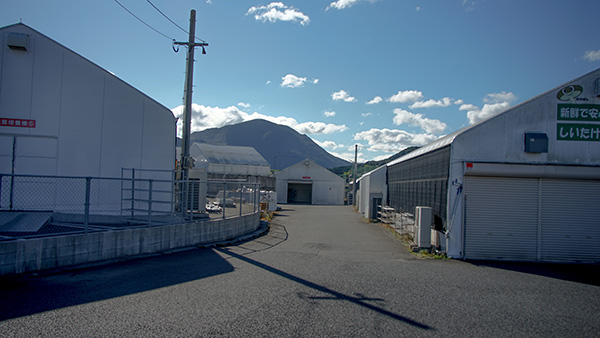
- A view of Kokura Kinoko Farm from near the entrance.
Meeting the founder and CEO, Mr. Yoshimura
The man who put the concept together and spearheaded this project, Noboru Yoshimura, cuts an everyman figure, tall, with a thick head of tousled hair, brown-tinged and highlighted. His kind smile and indeed every part of his bodily bearing radiate patience and calm. Mr. Yoshimura is an attentive listener, and a relaxed conversational partner. Prior to touring the farm’s facilities, we spent about fifteen minutes talking. My first and obvious question was why mushrooms? What had been the impetus to try growing mushrooms? Was there an exploratory phase looking at suitable businesses that considered other agricultural ventures, such as strawberries, which Fukuoka Prefecture is very famous for.I had expected this to be the case_emdash_after all why start with mushrooms was my thinking, especially shiitake. After having been circulating the Japanese industry from one side of the country to the other for the last three years, the reigning narrative and experience of people throughout all sides of the business could be summarized as: oversupply, high material costs, labor shortages, steadily shrinking prices, and tough competition. While many parts of mushroom farming, whether with bag or bottle cultivation systems, are well-suited for certain people with certain disabilities, as a business, it seemed to me a tough industry to jump in, even assuming food production was the aim.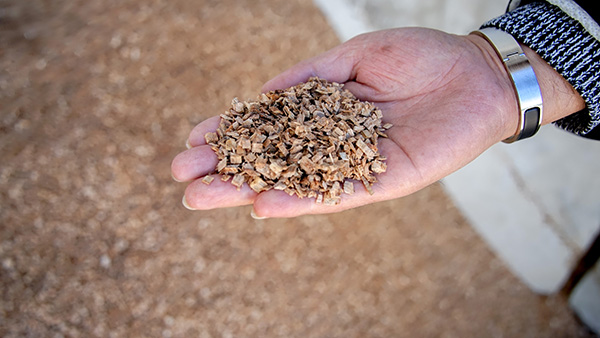 The farm uses a coarse woodchip for its substrate.
The farm uses a coarse woodchip for its substrate.- Yet, Mr. Yoshimura shook his head no, and explained that from the start the idea had been to work with mushrooms. The impetus came from landscaping firms that he had connections to. These landscapers produced quite a larger amount of tree-waste from trimmings and fallen or otherwise removed trees in the area. This led to the move to make a mushroom farm, even though currently, such locally produced landscaping waste provides only a small portion of their overall sawdust. As I would expect; the vast majority of such tree waste simply wouldn’t make suitable, quality mushroom substrate and in Japan, a farm needs to min-max their yields and consistency in order to make a profit. The problem, not just in Japan, but everywhere, is that plenty of nice ideas for local waste-recycling that technically work, don’t, for either logistical reasons, yield, consistency or some mixture of the three, produce a long-term profit in the mushroom sector.Kokura Kinoko Farm began from thinking about how to use this landscaping waste and provide a working environment suitable for those with class A or class B disabilities. Mr. Yoshimura soon saw that despite the large size of Kitakyushu City, very few mushroom producers operated in the area. The concept crystallized around the idea of expanding local food production and selling locally, with a focus on direct sales through roadside stations and Agricultural Co-Op stores that specialized in selling local produce direct from farmers. Mixed with that are the occasional request from local restaurants and food producers for the bulk orders, but the large majority of the roughly 80 metric tons of shiitake the small farm produces a year sell through direct to local consumers.
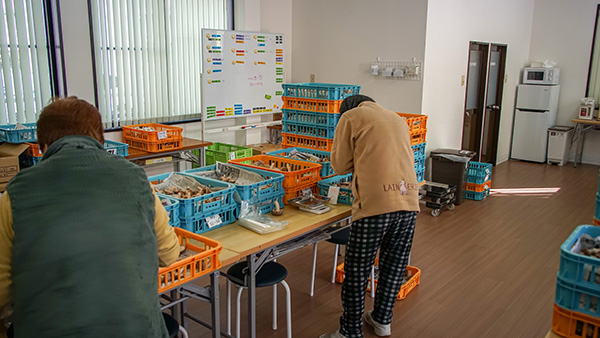
- Two older workers packaging shiitake. Their pace was slow, but the work environment was unrushed and workers were free to take breaks or adjust their pace to their physical abilities.
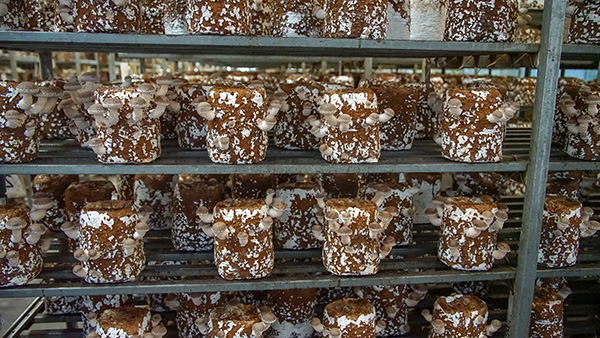
- One of the farm’s fruiting shelves.
A unique cultivation method
Kokura Kinoko Farm broke the mold for Japanese shiitake farming so hard, that it contradicts several basic tenets of the system here that I have described in this journal and other industry publications. The farm uses small, rounded 1.4 kg blocks, producing 600,000 of them a year and selling a substantial number of incubated blocks to other farms in the region, beyond just what their limited space allows them to fruit and harvest. Kokura is one of the only farms in the country using this size of cultivation bag. From my tour and our discussions, I would say there are two big reasons for this bag size:1) Ease of handling2) They only do one flush, for the most part.Indeed, it was a little irritating to, after having so loudly proclaimed many times to Western growers that Japanese shiitake farms absolutely have to have a second flush to break even, come across a farm that violated the rule. Despite numbering it after ease of handling, the fact that Kokura only does one flush seemed to me to be the most important reason for a 1.4 kg bag. The rounded, oblong shape of the cylindrical substrate “logs” would maximize the surface area to volume ratio. This improves yield per “log” while also making harvesting easier.Kokura sells almost entirely through local venues, paying no more than a modest percentage on each unit sold, and some occasional, small, transportation fees. This model cannot be said to be horizontally integrated; that is, selling direct from farm to consumer, but compared to most large shiitake farms in Japan, it cuts out at least one and more likely 2 middlemen. More importantly, Kokura sets their own prices, adjusting depending on how well product is selling.A key problem many mushroom farms in Japan have, is an over-reliance on large supermarkets. Such supermarkets generally put up a 30% mark up on price to cover their costs and they also deal directly with the wage-stressed and price finnicky mass consumer market. Kokura focuses on local food distribution outlets, targeting consumers who are already placing a small premium on buying as local and fresh as possible. In practice, this means their prices are essentially the same as a supermarket, but the venues themselves are paying more, because they aren’t taking as big a cut of the final consumer price as supermarkets are.The 1.4 kg block wouldn’t, and doesn’t, produce a very big second flush, by virtue of being smaller and more rapidly broken down by mycelium and also because the large surface area: volume ratio would encourage a larger first flush yield, which is going to come at the expense of the second flush. So, this is somewhat similar to typical Western shiitake farming practice, where the goal is to grab a big and efficient first flush and then move on. Even so, I would like to, a bit defensively, note that in Japan this only works, even for Kokura, because of the farm’s small and efficient structure and direct sales funnels through a very large local market (almost one million people).*I must note here, that the employment of class A and class B disabled individuals does not play any particular role in driving down costs. Labor costs in Japan are generally low, despite the difficulty in finding sufficient labor for these kinds of manual jobs. Over all, Kokura Kinoko Farm employs more people, and maintains support staff, all in order to provide employment for disabled individuals. Wages for class B disabled individuals, in particular, have a wide variation, and on the whole, losses in productivity plus expenses for special accommodation would eat up any moderate savings on labor, which itself is a comparatively small portion of mushroom farm’s operating costs in Japan anyway.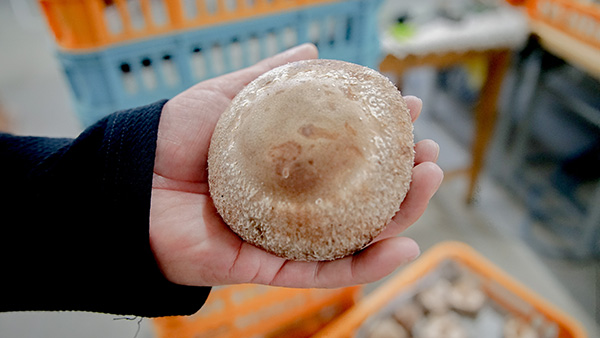
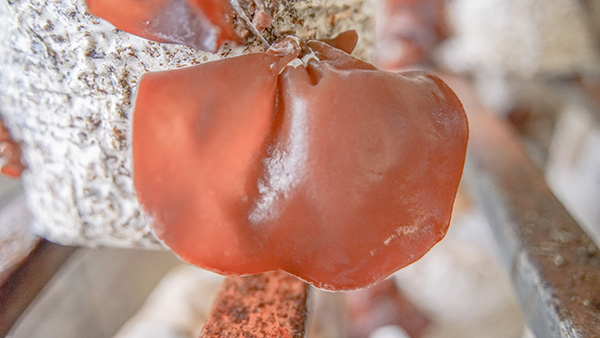 I was especially impressed with this fist-sized shiitake. Note the solidness of the fruiting body, the thickness of the cap, and the even, creamy coloration. One of the highest grade shiitake I have ever seen grown on substrate.A close-up of one of the farm’s wood ear mushrooms.
I was especially impressed with this fist-sized shiitake. Note the solidness of the fruiting body, the thickness of the cap, and the even, creamy coloration. One of the highest grade shiitake I have ever seen grown on substrate.A close-up of one of the farm’s wood ear mushrooms.The set-up
The farm has two divisions. The main location, a narrow but long strip of land somewhere just short of a hectare, is where employees with a class A disability work. This includes the mixer, filling machine, incubation, fruiting, and harvest. While the shape of the block is different and smaller, and the farm is only doing one flush, everything else was standard and familiar to me. I watched the filling machines to see how the smaller blocks moved at a faster pace, and inspected how they packed the autoclaves a bit differently.Still, the incubation time, around 100 days, and the temperature and humidity settings were standard. The farm consists of a series of long, narrow warehouses (the interior is just under ten meters in width), with warehouses designated for either incubation or fruiting. Because the farm sells a percentage of its incubated blocks to other farmers, incubation warehouses outnumber fruiting warehouses. This also plays into the farms strategizing around only doing a first flush; the lack of fruiting space makes that space valuable and the priority becomes more about maximizing room outputs, not material outputs.As always, the sheer efficiency of mushroom farming at producing food struck me. Japanese farming standards consider 600 kg of brown rice per hectare to be an excellent yield for Japanese cultivators of short-grained rice. Put into caloric terms, that is about 2,080,000 calories. The caloric content of 100 grams of shiitake is 25 calories - so just a small fraction of that of brown rice, however, even so a small shiitake farm like Kokura produces in the range of 20,000,000 calories worth of shiitake each year, making it nearly ten times more efficient than rice farming at producing calories.On the crisp, cool autumn morning I arrived at Kokura Kinoko Farm, Mr. Yoshimura actually led us to the second division first. The second division, about a ten-minute drive away, is an indiscrete one-story white building on the side of a broad thoroughfare. Dense developments of apartments and single-family homes flank the small building, which is where the farm does all of its sorting and packaging. According to Mr. Yoshimura, this is where all of the class B disability workers came to work. There was even a special van that the company used to pick people up at their homes or assisted living facilities.Like with many Japanese farms, packaging and shipping finishes in the AM hours, which is why we took a detour to the secondary facility first. Inside, the pace of the work was slow, but cheerful, with a surprising amount of natural light and a nice breeze flowing in from outside on open windows. While avoiding people’s faces, I took a few pictures of the packaging process, and zoomed on the gorgeous and good quality shiitake Kokura Kinoko Farm was producing. The fact that they are a relatively new farm made the quality and consistency even more impressive.Kokura Kinoko Farm has also begun dabbling in wood ear mushrooms during the warmer summer months, incubating them and fruiting them in the same rooms as shiitake. Mr. Yoshimura was still ambivalent about expanding production further, as he said the demand wasn’t exactly overwhelming and there were some challenges dealing with pests and fast spoilage. Despite mostly growing wood ear mushrooms in the summer, I did come across one shelf of them while touring the farm, and took the opportunity to take a few pictures of a mushroom variety I don’t get to see often in Japan.The farming operations ran very smoothly. The shovel car used to move sawdust into the mixer, and the forklifts used on the farm, are run by non-disabled employees, but otherwise people with class A disabilities handle most of the farm’s work. Most of the class A workers on the farm were quite young, and I was very impressed by the speed and consistency of their work. For many in this disability category, simple repetitive motions are easier and less stressful for them to do than positions that entail customer service or otherwise need strong communication skills. This also played into why Mr. Yoshimura soon fixed on mushroom farming as an ideal system for providing employment opportunities to those with disabilities.- One little detail that really struck me was that how, in addition to focusing on smaller, easier to handle blocks, the company had also made a special request for their cultivation bags to have small cuts on the ends, past the seal. The reason for this is so that the bags can be easily torn open and the substrate log removed faster, all without the need for scissors, which some of its workers may not legally be allowed to use for liability reasons. The attention to detail that represented to me embodied the ethos of a business that was created and organized around the idea of equal access to the opportunity to contribute to society.Because access is not a matter of lip service. Nor is it something you just hand out pills or allow workers to wear headphones or something like that. Access and fairness require changing systems of production, gearing processes so that a wider range of people are capable of working within them and the work itself is less stressful and more manageable. Led by Mr. Yoshimura, Kokura Kinoko Farm made that kind of top-bottom commitment, and showed me a much more palatable version of mushroom farming, one that contributed to the public welfare and local food systems at the same time. I admired the enterprise, especially the attempt to pair local, circular economies at the level of food production, along with wider employment opportunity and a disability-friendly work environment. When it comes to innovation and interesting concepts, I have to say that Kyushu never disappoints.

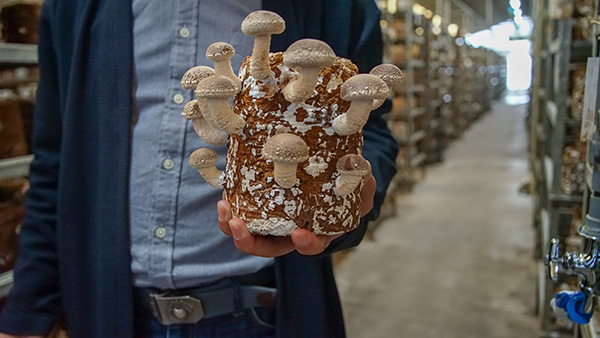 A close-up of another gorgeous shiitake.
A close-up of another gorgeous shiitake.





 1-2-13 Honmachi, Komoro city, Nagano prefecture, Japan 384-0026
1-2-13 Honmachi, Komoro city, Nagano prefecture, Japan 384-0026